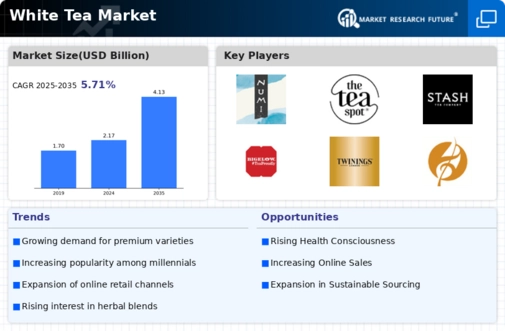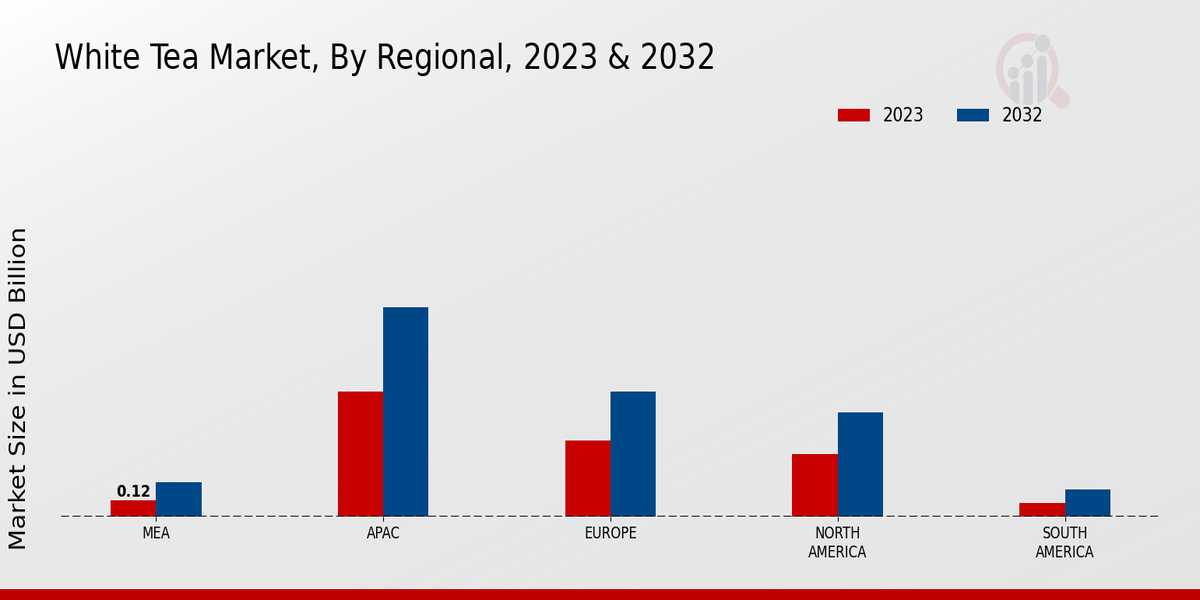Market Growth Charts
Market Growth Projections
The Global White Tea Market Industry is poised for substantial growth, with projections indicating a market value of 2.17 USD Billion in 2024 and an anticipated increase to 4.13 USD Billion by 2035. This growth trajectory is underpinned by a compound annual growth rate of 6.04% from 2025 to 2035. Factors contributing to this expansion include rising health consciousness, innovative product offerings, and the growing popularity of tea culture worldwide. As consumers increasingly prioritize quality and wellness in their beverage choices, the white tea market is likely to benefit from these trends, positioning itself as a key player in the broader beverage industry.
Rising Health Consciousness
The increasing awareness of health benefits associated with white tea is a prominent driver in the Global White Tea Market Industry. Consumers are increasingly seeking natural beverages that offer antioxidant properties and potential health advantages, such as improved cardiovascular health and enhanced metabolism. This trend is reflected in the projected market value of 2.17 USD Billion in 2024, as more individuals opt for healthier lifestyle choices. The shift towards organic and natural products further supports this growth, as consumers prioritize wellness and sustainability in their purchasing decisions. As a result, the demand for white tea is expected to rise significantly in the coming years.
Innovative Product Development
Innovation in product development is a driving force in the Global White Tea Market Industry. Manufacturers are increasingly experimenting with flavors, blends, and packaging to attract a broader audience. For instance, the introduction of flavored white teas and ready-to-drink options caters to younger consumers seeking convenience and variety. This trend is supported by the anticipated compound annual growth rate of 6.04% from 2025 to 2035, indicating a robust market response to innovative offerings. As brands strive to differentiate themselves, the continuous evolution of product lines is likely to enhance consumer interest and drive sales in the white tea segment.
Expanding Distribution Channels
The expansion of distribution channels plays a crucial role in the growth of the Global White Tea Market Industry. Retailers are increasingly recognizing the potential of white tea and are incorporating it into their product offerings. This includes supermarkets, specialty tea shops, and online platforms, which provide consumers with greater access to various white tea products. The convenience of online shopping has particularly contributed to this trend, allowing consumers to explore a wider range of options. As the market evolves, the projected growth to 4.13 USD Billion by 2035 suggests that enhanced distribution strategies will continue to facilitate the availability of white tea, catering to a diverse consumer base.
Cultural Influence and Traditions
Cultural influences and traditions surrounding tea consumption significantly impact the Global White Tea Market Industry. In regions where tea holds cultural significance, such as East Asia, white tea is often regarded as a premium beverage, associated with rituals and social gatherings. This cultural appreciation fosters a loyal consumer base that values the quality and heritage of white tea. As globalization continues to spread these traditions, the market is likely to see an increase in demand from diverse demographics. The interplay between tradition and modern consumption patterns may further enhance the market's growth trajectory, as consumers seek authentic experiences in their beverage choices.












